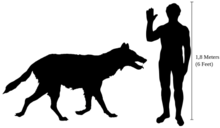Canis dirus
| Canis dirus | ||||||||||||
|---|---|---|---|---|---|---|---|---|---|---|---|---|

Mounted skeleton of C. dirus |
||||||||||||
| Temporal occurrence | ||||||||||||
| Middle Pleistocene to Upper Pleistocene | ||||||||||||
| until about 10,000 years ago | ||||||||||||
| Locations | ||||||||||||
|
||||||||||||
| Systematics | ||||||||||||
|
||||||||||||
| Scientific name | ||||||||||||
| Canis dirus | ||||||||||||
| Leidy , 1858 | ||||||||||||
Canis dirus ( Latin for 'terrible dog') is a species of dogs (Canidae)that became extinct about 10,000 years ago . It belonged to the genus Canis (wolf and jackal species) and lived in the Pleistocene of North and South America. Canis dirus was not the ancestor of today's wolf ( Canis lupus ), as is often assumed. Its common English name is 'dire wolf' ( English dire 'terrible, terrible' ).
Appearance
Canis dirus resembled a wolf in physique, but was slightly larger than this. The average head-to-torso length was around 1.5 m and the weight was around 50 kg. In contrast to the wolf, Canis dirus was a little more stocky and had shorter, stronger limbs. The head was larger than that of a correspondingly large wolf, but the brain volume was smaller. Its teeth were stronger than those of any other species in the Canis genus .
Way of life
The shorter legs suggest he wasn't a particularly good runner. In connection with its powerful fangs , which were able to break open even larger bones, this suggests scavenging . Possibly it lived like a hyena and occupied its ecological niche on the American continent. This thesis is supported by strong signs of wear and tear on the animals' teeth. On the other hand, some fossils of Canis dirus healed fractures, which are identical to those also present wolves sometimes in confrontation with an especially large and well-fortified prey such as moose or elk carry. It is therefore likely that these animals also actively hunted, much like today's spotted hyenas . Hyenas also show strong signs of wear on their teeth, but regardless of whether their food is self-hunted prey or found carrion, since they almost always completely utilize carcasses.
Finds and distribution
Canis dirus evolved from Canis armbrusteri . This occurred for the first time in the middle Pleistocene around 800,000 years ago and spread over the American double continent. It later died out in North America but survived in South America, where it likely became the ancestor of Canis dirus . This originated in South America and from there reached North America, which it reached about 100,000 years ago. Canis lupus migrated to North America from Eurasia 200,000 years earlier . For a period of around 100,000 years, the wolf and Canis dirus lived together in the same habitats, but around 10,000 years ago the “direwolf” suffered the same fate as many other animals on the American continent. It died out along with mammoths , American mastodons , short-faced bears , the saber-toothed cat smilodon and the giant sloth , while the wolf ( Canis lupus ) has survived to this day. Canis dirus occurred in the late Pleistocene from Alberta ( Canada ) to Peru .
The most famous sites are near Rancho La Brea in what is now California . Here, the fossils of 3,600 individuals have been unearthed, more than any other animal species found there. Fossil finds in Arkansas provide evidence that the last Canis dirus may have survived until 4,000 years ago.
Cultural reception
Canis dirus is often taken up as a particularly large, primeval and intelligent wolf in books and films of the fantasy genre . Often these creatures only have their name in common with the extinct species, for example, because their bodies are heavily overdrawn or depicted or described in a way that is adapted to the respective situation.
- In Die Legende der Wächter and the offshoot series The Wolves of the Beyond , the Canis dirus plays a larger role.
- As a dread wolf, he is also a classic creature from Dungeons & Dragons , which often represents a stronger alternative to the simple wolf as a wild animal or animal companion.
- Furthermore, the existing shadow wolf (in the original English Direwolf ) as a living being and emblem in the fantasy saga A Song of Ice and Fire , as well as, based on this television series Game of Thrones .
- In the survival game ARK for PC and consoles, the "Direwolf" is represented as a pack animal between three and five animals. Its habitat is the cold mountain regions or the ice area, the coat color is therefore gray to white. Its size is only marginally larger than what skeletal finds show.
literature
- Paul S. Martin , Richard G. Klein (Eds.): Quaternary Extinctions. A Prehistoric Revolution. The University of Arizona Press, Tucson AZ 1984, ISBN 0-8165-1100-4 .


